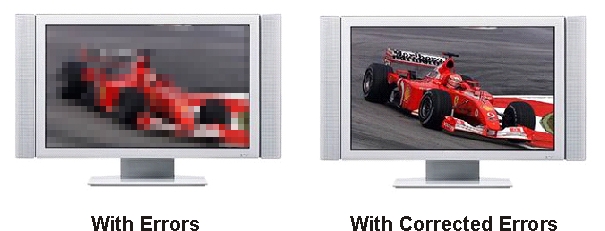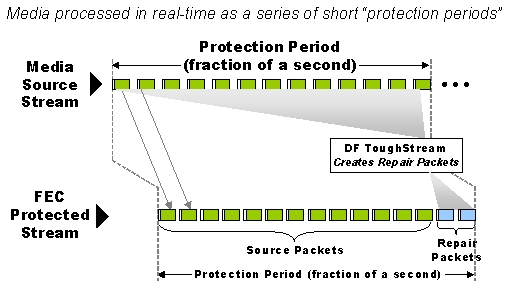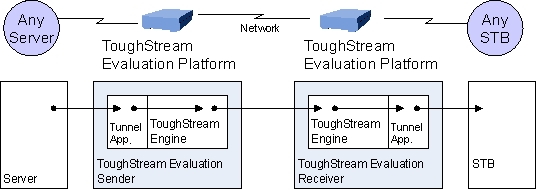|
 |
|
This month we talked with Charlie Oppenheimer from Digital Fountain about how to maintain or improve the quality of IPTV programs without significant additions to transmission overhead and small changes to the transmission and reception equipment. Oppenheimer explained that the effective use of packet loss correction can increase the number of DSL lines that qualified for IPTV services and improve service quality to reduce customer support calls.
Packet losses have a dramatic affect on the quality of IPTV programs. Because digital programs use very efficient compression processes, a loss of a single packet can result visible and audible effects including "tiling", frozen frames, retained images and error blocks that remain on the display for several seconds.
Digital Fountain has developed an enhanced erasure coding system called "DF ToughStream" that combines original transmitted data (source packets) along with sophisticated related correction information (repair packets) to dramatically increase the ability to recover (recreate) lost packets in an IPTV (or any other type) of packet communication system. The ToughStream system is specifically designed to maximize quality, minimize bandwidth usage while maintaining fast channel change times. ToughStream is offered as software modules that are integrated into head end gear and set-top-boxes.
According to Oppenheimer, often times, when IPTV operators think about packet loss, they think in terms of long-term averages. However, in the case of video delivery over IP, averages are meaningless because it is the amount of loss during very short periods (e.g. the duration of a single MPEG Group of Pictures) that determines whether the subscriber experiences degraded presentation. Consider the following case study:
Case Study
Digital Fountain has recently engaged an IPTV provider that reports a handful of packet loss events per day lasting about 30ms in length. These events are caused by burst noise within the last mile of the network. In addition, random packet loss events occurring at various points across the network add to the packet loss problem. This provider reports a total packet loss level of less than 0.1%, which represents an acceptable'
rate of loss for any network based on conventional standards. However, a
closer look uncovers a much larger problem that most IPTV providers are
only now beginning to understand. |
In a typical IPTV network, streamed data is sent in very small groups of packets over a very short period of time. These small groups are typically in a range of 250ms to 500ms in duration so as to minimize latency and speed channel change times. When a packet loss event of 30ms occurs over a 250ms period of time, the effective loss rate is actually around 12% for that period of time. A loss of 12% is considered catastrophic to picture and sound quality. The result is a poor viewing experience, and a dissatisfied customer.
If multiple packet loss events such as those described above occur over say 1 or 2 hours, the negative impact on the viewing experience is magnified, as the problems will appear to be occurring more frequently.
Even though this IPTV provider reported acceptable levels of long-term average packet loss, they also reported that 20% of their customer service calls are packet loss-related! Such data demonstrates that traditional network measures have little relevancy when delivering streaming media over IPTV networks. It is clear that IPTV providers need to take a different approach to mitigate the packet loss problem.
Packet losses can occur for many reasons including unexpected events (e.g. electrical impulse noise on DSL lines, lightning spikes, etc.), system reconfigurations and congestion. Even in the best designed and engineered IP networks, packet loss will occur on occasion. In fact, the IP protocol is a "best effort" protocol designed specifically around the idea that economically efficient networks are sized to support average traffic loads vs. maximum conceivable spikes (i.e. "congestion"). Packet discard is actually a feature of IP routers that is used to deal with momentary traffic spikes. And so, an IP system with zero packet loss would be one that disregards the fundamental economic advantage of IP networks; it would be a network that would always have excess capacity.
Figure 1 shows how some of the effects of packet loss on IP video and how erasure correction can prevent these errors. This example shows a video image that has a small percentage of errors and that these errors result in the display of error blocks.
|
|
|
|
 |
|
Figure 1, Effects of Packet Loss on IP Video
|
|
Digital Fountain has developed an enhanced erasure coding system called "DF ToughStream" that combines original transmitted data (source packets) along with sophisticated related correction information (repair packets) to dramatically increase the ability to recover (recreate) lost packets in an IPTV (or any other type) of packet communication system. ToughStream allows developers of IPTV streaming applications to quickly and easily achieve entertainment quality over ordinary IP networks, despite the presence of varying levels of packet loss. Incorporating Digital Fountain's DF Raptor™ Forward Error Correction (FEC) technology, DF ToughStream™ enables real-time, perfect streaming with the least amount of bandwidth overhead, lowest computational requirements and highest packet loss protection. |
The secret to the Digital Fountain system is its simultaneous use of error correction algorithms that use the underlying transmitted data to create interrelated formulas that are contained in the repair packets. The use of simultaneous correction codes that leverage (inter-relate) the raw data contained in the transmitted data allows for a much lower overhead for error correction.
Figure 2 shows the basic process for error eradication system. This diagram shows that the media source stream is analyzed over a protection period to produce repair packets. The repair packets are added at the end of a block of data which reduces the amount of transmission delay time.
|
|
|
|
 |
|
Figure 2, Digital Fountain Error Eradication System
|
|
To setup the ToughStream system, a relatively low complexity software engine is located in the server and the client. The memory footprint for this software engine is approximately 100k bytes of data and the amount of additional CPU processing capability that is required ranges from about 2 to 5 million instructions per second (MIPS).
Figure 3 shows the how the error eradication system can be used in an IPTV system. This diagram shows that the original video is processed using the Digital Fountain error eradication system on any server. The ToughStream evaluation sender appends the repair packets to the transmitted data. At the receiver, the ToughStream evaluation receiver extracts and applies the repair packets to create the original video signal.
Digital Fountain's technologies can help IPTV system operators provide reliable quality for a well-designed IPTV network. Digital Fountain's ToughStream application eliminates the common packed loss-related problems, such as picture and sound degradation and slow channel change times. As a flexible software solution that is deployed at the application level, Digital Fountain's technology maximizes IPTV providers' existing infrastructure investments, and enabling expanded revenue opportunities. Digital Fountain's technologies has been adopted by leading international standards groups including DVB, 3GPP, and IETF
|
ADDITIONAL INFORMATION:
Sources of Packet Loss
analog and electro-magnetic interference, such as impulse noise
logical and physical bandwidth constraints
equipment issues and incompatibilities
operator error or intentional procedure
Analog and EM interference are typically caused by external factors, including weather and nearby electric equipment, such as radios, televisions, and kitchen blenders. Such external factors can also involve the IPTV providers own equipment. Due to the intermittent nature of these causes, they can exceed the physical layer correction models resulting in packet loss.
Logical and physical bandwidth constraints arise from both configuration selection as well as equipment tolerances. QoS constraints necessarily involve selecting bandwidth limits that can produce packet loss if not managed properly. Excessive jitter or bursty traffic can exceed input buffers or packet processing capabilities, also resulting in packet loss.
Equipment issues include such items as bad fiber connections, spurious messaging, and improper packet handling (e.g., inserting interpacket jitter). Incompatibilities include using hardware that is
|
|
 |
|
Figure 3, Digital Fountain Error Eradication System |
|
standards-based yet
not fully interoperable. This occurs frequently with new technologies,
currently with the new H.264 encoders/decoders.
Operator error can induce packet loss by causing short equipment outages (e.g., unplugging the wrong cable during maintenance). An example of an intentional procedure is where an operator intentionally resets an encoder to attempt to clear up a video issue. Resetting an encoder produces a short outage until the encoder is fully restarted.
Symptoms of Packet Loss
Video and/or audio quality degradation
Slow channel change times
Reduced transport reach
Packet loss has a direct correlation with video and/or audio degradation. The overwhelming telco install base uses multicast, which provides no protection from packet loss (unlike the TCP/IP model used, for example, for web browsing). The extent of the degradation is primarily determined by the frame of video affected (reference I-frames being the worst) and the compression technology used (MPEG-4 being better than MPEG-2 at hiding the effects of packet loss). Excessive packet loss of as little as 1x10e-5 (or one packet per minute on a MPEG-4 SD channel) can be considered
unviewable.
With xDSL deployments, operators select maximum reach based on a target bandwidth, e.g., 10Mbps, which is usually selected based on a combination of intended services (voice, data at some guaranteed rate, 2 MPEG-4 SD channels, 1 MPEG-4 HD channel, etc.). Customers outside this reach are not offered the services or are offered a reduced subset, e.g., data and voice only. xDSL equipment provides for physical layer forward error correction (FEC) to correct analog and EM noise by throttling back on the allowed bandwidth. So as the amount of noise increases, the xDSL
equipment will dynamically
reduce the errors by increasing FEC, which has the side effect of reducing
bandwidth. Less aggressive profiles (due to this extra noise) reduce overall reach and limit the customer base.
|
During channel change, MPEG decoders must wait until the next reference frame (or I-frame) before presenting the image to the viewer. Packet loss during this I-frame can cause the decoder to wait until the next good frame, thus significantly increasing the channel change time. In the case of MPEG-4 systems, these I-frames can be as high as 2 seconds apart. Channel change times have been one of the characteristic problems with digital video, specifically IPTV.
As packet loss is such a problem, operators will scrutinize their transport networks to eliminate noise and reduce packet loss wherever possible. Fibers will be reanalyzed and/or reterminated, questionable connectors will be replaced, and problematic boxes and/or blades will be swapped out, all as part of an effort to remove packet loss from the system. In spite of this effort, burstiness (consecutive packet loss over a period of time) will occur, so operators must over allocate bandwidth to prevent exceeding maximum channel limits, simply to prevent occasional, or even highly infrequent, burstiness
that could lead to packet loss and reach will be reduced, to account for
intermittent impulse noise. In short, the system is over-engineered,
swapping efficiency and reach for a positive user experience. Usually this
results in more conservatism than necessary.

|
|
 Charlie Oppenheimer is a senior business executive with more than 20 years of experience, specializing in networking and communications. Prior to joining Digital Fountain, he was CEO at Aptiva (acquired by Yahoo!); and Oneworld Systems. Charlie Oppenheimer is a senior business executive with more than 20 years of experience, specializing in networking and communications. Prior to joining Digital Fountain, he was CEO at Aptiva (acquired by Yahoo!); and Oneworld Systems.
Digital Fountain software develops technologies and systems that optimize the delivery of digital media over any network. Digital Fountain's technologies eliminate the common limitations associated with digital media distribution over private and public networks while maximizing infrastructure investments and expanding revenue opportunities.
|
|
|
|